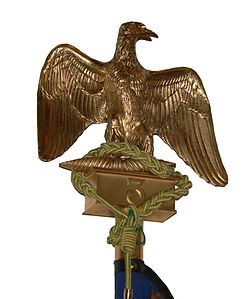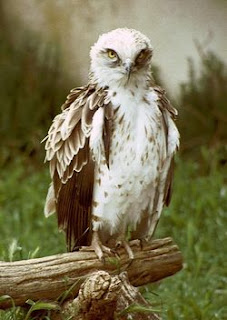The word
The modern English name of the bird is derived from the Latin term aquila by way of the French Aigle. The Latin aquila may derive from the word aquilus, meaning dark-colored, swarthy, or blackish, as a description of the eagle's plumage; or from Aquilo, the Latin version of Greek Boreas, or north wind.
Old English used the term Earn, related to Scandinavia's Ørn. The etymology of this word is related to Greek ornos, literally meaning "bird". In this sense, the Eagle is the Bird with a capital B.
[edit] Eagles as national symbols

Coat of arms of the town of Berg en Terblijt in the Netherlands, an example of the prolific use of the eagle in European heraldry.
The eagle has been used by many nations as a national symbol, depicting power, beauty and independence.
- Arabic world. Many Arabic states and organisations use eagles as symbols, e.g. the PLO.
- Czech Republic. The Czech Republic integrates three historical parts: Bohemia (with a double-tailed lion in the emblem), Moravia and Silesia (both with female eagles in their emblems - red-and-white chequered and black).
- Hellenistic Egypt. The Ptolemaic rulers of Egypt used it as their seal.
- First French Empire. Napoleon Bonaparte used the Roman Golden Eagle as the symbol of his new French empire.
- Ghana. Two eagles are part of the coat of arms of Ghana.
- Mexico. The bird on the Mexican coat of arms and flag is a Golden Eagle.
- Moldova. An eagle is part of the coat of arms and flag of Moldova.
- Nigeria, The eagle is part of the Coat of Arms of Nigeria and the Seal of the President of Nigeria.
- The Philippines. The endangered Philippine Eagle is the national bird of the Philippines.
- Poland. A white eagle on a red field is the coat of arms of Poland.
- Romania. The eagle is also part of the coat of arms of Romania
- Rome. The Romans used it on the standards of their armies. From this derives:
- The late Byzantine Empire) chose a two-headed golden eagle as its symbol. It is popularly that one head symbolised ancient Rome, and the other head symbolised "new Rome" at Constantinople. From this derives:
- Albania. The two-headed eagle is the emblem of "Shqipëria" or Land of the Eagles, which is known in English as Albania (see The Tale of the Eagle for the legendary origin of the name)
- Russian Empire. After the fall of Constantinople, the Russian Empire took the two-headed eagle as its own symbol.
- Charlemagne and Holy Roman Empire. After his crowning as the new Roman Emperor, Charlemagne adopted the ancient Roman eagle as his own symbol. The Holy Roman Empire born of his kingdom took the eagle, but the Habsburgs replaced the golden eagle by an imperial eagle. From this derives:
- Austria. The Austrian Empire had a two-headed eagle as its symbol. After the abolition of Austria-Hungary, Austria took as its symbol a one-headed eagle in the modern coat of arms of Austria.
- Germany and Prussia. Prussia, and later Germany have used a black eagle as their national symbol.
- Spain. The "Catholic Kings", Isabella and Ferdinand, used the Golden Eagle as a part of the royal shield. The eagle was on the Spanish shield until 1978.
- Serbia/Montenegro. The Two-headed eagle is the emblem of Serbia, Montenegro, and Serbia and Montenegro.
- The Seljuk Turks and Ottoman Turks used a double-headed eagle as coats-of-arms.
- USA. The United States has adopted the North American Bald Eagle as its national emblem. Although the Golden Eagle is found in North America, U.S. references to an unspecified "eagle" are often to the Bald Eagle, especially in an emblematic context. However, a few U.S. coins have shown the Golden Eagle (recognizable because the feathering on its legs extends to the base of the toes);[3] [4] this error is the cause of the expression "illegal eagle".[citation needed]
Eagles as religious objects
In Jewish tradition the eagle is a symbol of greatness, and leaders such as the medieval sage Maimonides and the Lubavitcher Rebbe, Rabbi Menachem M. Schneerson, have been referred to by their peers and students as "The Great Eagle". The Torah compares God Himself to an eagle in Deuteronomy, 32.11-12. "As an eagle awakens its nest, hovering over its fledglings, it spreads its wings, taking them and carrying them on its pinions. [So] the Lord guided them [the Israelites] alone, and there was no alien deity with Him."
Eagle lecterns are very common in Christian churches and cathedrals. The eagle is the symbol used to depict John the Apostle, whose writing most clearly witnesses the light and divinity of Christ. In art, John, as the presumed author of the Gospel, is often depicted with an eagle, which symbolizes the height he rose in the first chapter of his gospel. See Names of John.
The eagle is a sacred bird in some cultures and the feathers of the eagle are central to many religious and spiritual customs, especially amongst Native Americans in the United States and First Nations in Canada, as well as among many of the peoples of Meso-America. Some Native American peoples revere eagles as sacred religious objects and the feathers and parts of Bald and Golden Eagles are often compared to the Bible and crucifix. Eagle feathers are often used in various ceremonies and are used to honor noteworthy achievements and qualities such as exceptional leadership and bravery. In the cultures of the Northwest Coast, Eagle is also a supernatural being and also the ancestor and reatures in the heraldic crests of important clans known as totem poles.
Despite modern and historic Native American practices of giving eagle feathers to non-indigenous people and also members of other tribes who have been deemed worthy, current United States eagle feather law stipulates that only individuals of certifiable Native American ancestry enrolled in a federally recognized tribe are legally authorized to obtain eagle feathers for religious or spiritual use. In Canada, poaching of eagle feathers for the booming U.S. market has sometimes resulted in the arrests of First Nations person for the crime.[citation needed]
Eagles as organizational symbols
- Australia. The Royal Australian Air Force uses the Wedge-tailed Eagle on its coat of arms. There is also an Australian Rules Football club called the West Coast Eagles.
- Greece. The double-headed eagle is the emblem of the Greek sport clubs AEK (black eagle on yellow background) and PAOK (black eagle on white background). It is a symbol of the clubs' origins, since both clubs were founded by Greeks who fled to Greece from Constantinople in 1922-23.
- Italy. The Roman eagle is the symbol of the Roman sports club S.S. Lazio.
- Nigeria. The Nigeria Football Association, the nation's football (soccer) governing body, has a green eagle perched on a football as its organisational symbol and logo. The Nigerian national football team is known as the 'Super Eagles', the under-20 youth team as the 'Flying Eagles', and the under-17 national side as the 'Golden Eaglets'. They all have an eagle as their symbol.
- Portugal. Eagle is the symbol of the Portuguese football team Sport Lisboa e Benfica.
- Turkey. Black Eagles is used for the Turkish sports club Beşiktaş J.K..
- USA. Eagles are a common motif for American companies and organizations seeking association with a national identity. A few examples are the United States Postal Service, the Constitution Party, and the name of the highest rank in the Boy Scouts of America. Among the sports teams whose mascot is an eagle, the only one in a major league of a major sport (by U.S. standards) is the Philadelphia Eagles (American football).
- China. Flying eagle is the logo of Shatin Pui Ying College in Hong Kong. In this school, an award is called Flying Eagle Award with the eagle badges as prizes.
 The Black-bellied Whistling Duck (Dendrocygna autumnalis) is a whistling duck which breeds in the southernmost USA and tropical Central and South America.
The Black-bellied Whistling Duck (Dendrocygna autumnalis) is a whistling duck which breeds in the southernmost USA and tropical Central and South America.








